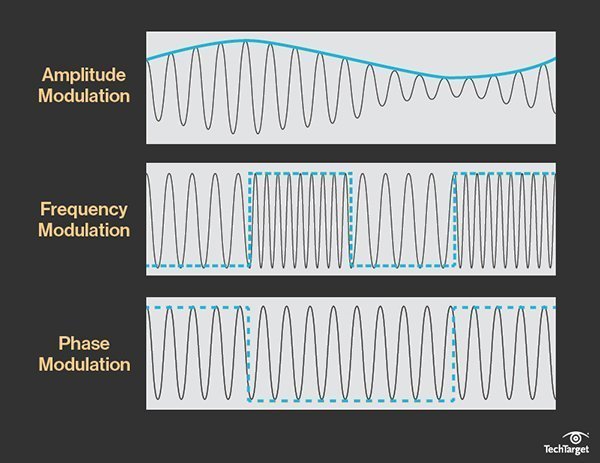Modulation
Modulation is the addition of information to an electronic or optical carrier signal. A carrier signal is one with a steady waveform -- constant height (amplitude) and frequency. Information can be added to the carrier by varying its amplitude, frequency, phase, polarization (for optical signals), and even quantum-level phenomena like spin.
Step 1: modulation definition
Modulation is the addition of information to an electronic or optical carrier signal. A carrier signal is one with a steady waveform -- constant height (amplitude) and frequency. Information can be added to the carrier by varying its amplitude, frequency, phase, polarization (for optical signals), and even quantum-level phenomena like spin.
Modulation is usually applied to electromagnetic signals -- radio, lasers/optics and computer networks. Modulation can even be applied to direct current (which can be treated as a degenerate carrier wave with amplitude 0 and frequency 0) mainly by turning it on and off (as in Morse code telegraphy), or applied to alternating current (as with power-line networking).
Common modulation methods include the following:
1. Amplitude modulation (AM), in which the height (i.e., the strength or intensity) of the signal carrier is varied to represent the data being added to the signal.
2. Frequency modulation (FM), in which the frequency of the carrier waveform is varied to reflect the frequency of the data.
3. Phase modulation (PM), in which the frequency of the carrier waveform is varied to reflect changes in the frequency of the data (similar but not the same as FM).
4. Polarization modulation, in which the angle of rotation of an optical carrier signal is varied to reflect transmitted data.
5. Pulse-code modulation, in which an analog signal is sampled to derive a data stream that is used to modulate a digital carrier signal.
Radio and television broadcasts and satellite radio typically use AM or FM. Most two-way radios use FM, although some employ a mode known as single sideband (SSB).
More complex forms of modulation include phase-shift keying (PSK) and Quadrature Amplitude Modulation (QAM).

Three types of modulation
A computer modem allows a computer to connect to another computer or to a data network over a regular analog phone line by using the data signal to modulate an analog audio tone. A modem at the far end demodulates the audio signal to recover the data stream. A cable modem uses network data to modulate the cable service carrier signal.
Sometimes a carrier signal can carry more than one modulating information stream. A process called multiplexing combines the streams onto a single carrier -- e.g., by encoding a fixed-duration segment of one, then of the next, for example, cycling through all channels before returning to the first, a process called time-division multiplexing (TDM).

Sep 25,2015
1,144 viewsReport item
- Comments(0)
- Likes(0)
Upload photo
You can only upload 5 files in total. Each file cannot exceed 2MB. Supports JPG, JPEG, GIF, PNG, BMP
0 / 10000















